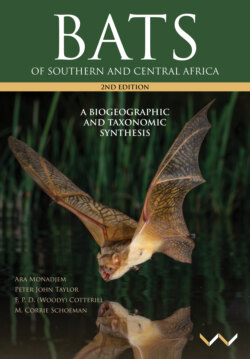Читать книгу Bats of Southern and Central Africa - Ara Monadjem - Страница 13
На сайте Литреса книга снята с продажи.
MUSEUM COLLECTIONS AND PIONEERING RESEARCHERS
ОглавлениеDuring the eighteenth and nineteenth centuries, early explorers and hunters such as Temminck and Wahlberg collected biological specimens in southern Africa, which were then sent back to the major museums of Europe, such as the Natural History Museum in London (previously known as the British Museum of Natural History). Within the past few decades, mammalogists including Knud Andersen, Wim Bergmans, J. L. Eger, D. L. Harrison, R. W. Hayman, J. Eric Hill, J. Edwards Hill, J. Kingdon, D. Kock, K. F. Koopman, R. L. Peterson, D. R. Rosevear and O. Thomas, have done an excellent job of making much sense out of these invaluable historical collections, and have published taxonomic and biogeographical treatises in books, checklists and journals.
In the early twentieth century, local mammalogists, notably G. C. Shortridge, W. L. Sclater, and A. Roberts, worked prodigiously to build up collections of southern African bats and other mammals (Smithers 1984). Their researches were part of broader faunal surveys and research, especially of the mammals of the region. Many benefited directly and in kind from the devotion of Sir John Ellerman, a most studious researcher of the worlds' rodents. A significant milestone was the publication of Southern African Mammals 1758–1951: A Reclassification (Ellerman et al. 1953), which remains a valuable reference for the mammalian taxonomist. This tradition was continued in the latter part of the twentieth century by several biologists – notably Reay H. N. Smithers, J. A. J. ‘Waldo’ Meester, R. C. Wood and W. Frank H. Ansell made invaluable collections of bats and many other mammals. In the 1960s and 1970s, the Smithsonian Institution initiated groundbreaking surveys of African mammals in at least 13 African countries; the vast collections obtained are a testimony to many dedicated field collectors, including Tim N. Liversedge and John Herbert in southern Africa (Schmidt et al. 2008). This led to the compilation of the authoritative The Mammals of Africa: An Identification Manual, under the editorship of Waldo Meester and H. W. Setzer between 1971 and 1977 – the chapter on Chiroptera by Robert W. Hayman and J. Edwards Hill still includes the most up-to-date identification keys available for much of Africa. It was superseded to some extent in southern Africa by Classification of Southern African Mammals (Meester et al. 1986, updated by Bronner et al. 2003), in which Meester and co-authors derived the keys for Chiroptera largely from Karl L. Koopmans' authoritative Bats of the Sudan (1975).
The significance of three publications on African Chiroptera can be singled out, because they greatly improved the state of knowledge: The Bats of West Africa (Rosevear 1965), The Bats of the Congo and of Rwanda and Burundi (Hayman et al. 1966) and the reappraisal by Koopman (1965) of Lang and Chapins' Congo Collection housed in the American Museum of Natural History in New York. These resolved major taxonomic problems in African bats that had persisted for decades, many since the nineteenth century. In addition to their taxonomic resolution, these publications presented a wealth of new biogeographical data. Together, this refined knowledge created the foundations for the continental synthesis of Hayman and Hill (1971). All four of these works continue to underpin bat research across Africa today.
Behavioural and ecological studies of African bats began with the extensive field observations published by Lang and Chapin (1917). Verschuren (1957b) published a detailed monograph of the roosting and foraging ecology and behaviour of the bats of Garamba National Park, northeast Congo; his pioneering observations on roost selection have yet to be matched. Brosset (1966a, b) obtained equally detailed data on the biology of the bats of Gabon and Congo (Brazzaville). Through the 1970s and 1980s, M. B. Fenton and colleagues studied the foraging ecology and behaviour of southern African bats intensively in Zimbabwe and northeastern South Africa. As a result, the bat assemblages of the Sengwa Wildlife Research Area in Zimbabwe (Fenton 1985) and the Pafuri region of the Kruger National Park (Aldridge and Rautenbach 1987) became among the best known worldwide. This research also resulted in many new distribution records and collections of museum specimens, which are still used in taxonomic revisions. Not least, these studies brought a welcome focus on research into the echolocation of the regions' bats. Detailed studies of the reproduction of selected species of African bats (including McWilliam 1982 and Cotterill 1989) provided valuable data (reviewed by Bernard and Cumming 1997), which were associated with significant additions to museum collections.
